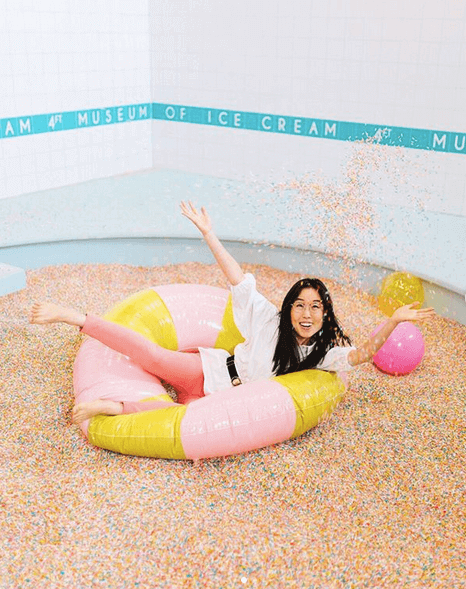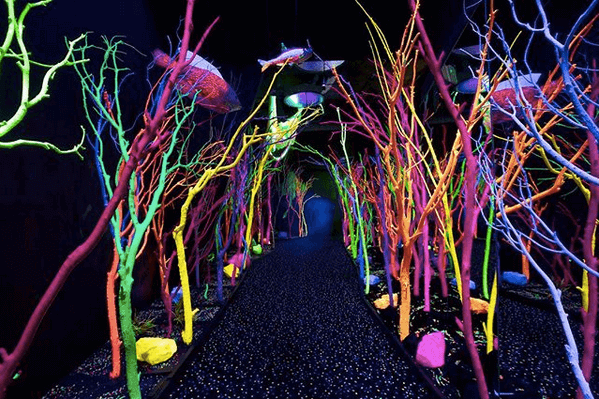There is no surprise that brands and businesses are being required to think outside-of-the-box when it comes to marketing. With competitive organic and paid landscapes, new and emerging brands have to be different, unique, and really shake things up to break through the noise mega brands create. As more marketers realize the need for connecting with audiences in ways that are fun, memorable, and genuine, we’re seeing a boom in experiential marketing. But we’re not talking about just any experience. The hottest trend in experiential marketing recently is immersive, interactive pop-ups.
Let’s take a look at the most zany pop-up activations to hit the streets, and why they were so effective.
Museum of Ice Cream

Photo Credit Museum of Ice Cream
What it is:
The Museum of Ice Cream bills itself as an interactive art exhibit. Visitors can romp and play on MOIC’s candy and ice cream themed exhibits. While it sounds like an experience just for children, most of the museum’s visitors are adults aged 25 – 40 — the perfect playground for influential millennials to explore their creativity and create a completely organic marketing movement.
Why it works:
- Insta-beauty
Instagram is huge. The founders at MOIC played off the Gen Z Instagram craze by creating gorgeous, photogenic events. They strategically incorporated backdrops, selfie booths, props, and signs with their hashtags throughout the experience. This increased their social reach while helping visitors build their own Instagram klout, equaling social media virality.
2. Sensory experiences
Did you know that smell is the sense that’s most closely linked to memory? If you want to make a mark like MOIC, you need to incorporate sensory experiences. MOIC not only visually draws consumers in, but their use of taste and smell captivate fans as they travel from one activation to the next.
3. Nostalgia
MOIC’s installation works for one big reason: human emotions. MOIC lets people relive their childhood through nostalgic experiences. Genius. As a true marketer, there is no shock to the disruption MOIC has made. They carefully thought through every inch of the consumer’s experience when they crafted their first activation.
Enchant Christmas

Photo Credit Enchant ChristmasWhat it is:
Enchant Christmas bills itself as the world’s largest light maze. It also features a Christmas market, ice skating, holiday-themed treats, and live music.
Why it works:
1. Effective event timing
Enchant Christmas takes advantage of seasonal buying patterns and time of year. The greatest marketing campaigns are built around consumer demand and timing – Enchant Christmas checks the box on both with their all-inclusive holiday popup. As it nestles itself perfectly into the holiday season where friends, families, and loved ones are spending more quality time with each other, Enchant Christmas unites extended families traveling into town and even local communities and neighbors who so often don’t spend as much time together. Our biggest takeaway is to check your calendar. It seems basic, but it’s critical to know if other competing events or holidays will impede or encourage event attendance. It’s also a good litmus test to see what your competitors are doing, too.
2. Storytelling
Enchant Christmas is also effective because it creates a story for each popup. In fact, stories are one of the most effective ways to communicate. Stories aren’t just reserved for bedtime but storytelling has recently been adopted as a popular component of content strategy.
3. Research & Data
If you don’t understand your audience, you won’t be able to create events they love. It’s essential to survey your target audience to determine pain points, hobbies, and more to determine what events they’ll love. Enchant Christmas wasn’t thrown together on a whim. It was the result of careful data collection and analysis to ensure it would be a hit. If you want to replicate the success of this event, analyze data from your website, social media, and email campaigns. You’ll see what affinity categories your users are in and how you can best appeal to them through interactive experiences.
Meow Wolf

Photo Credit Meow WolfWhat it is:
Designed by a scrappy group of local artists who wanted to relive childhood, Meow Wolf is marketed as a colorful “choose your own adventure” wonderland. It’s essentially a museum/theme park that amazes visitors through lights, performance, music, and a dash of weirdness.
Why it works:
- Charitable mission
Meow Wolf donates a large portion of their proceeds to arts charities. This encourages attendees to support their mission of creating art across the U.S. A co-branded event increases your reach through the charity’s promotional channels, encourages visitors to support your event, and does a little extra good in the world.
Also, younger audiences are more likely to support your mission when you give proceeds to a charity. Meow Wolf made an honorable and strategic business decision when they considered co-branding their event with art charities their target audience was passionate about.
2. Revolving content
Because attendees have a different experience each time they go, Meow Wolf taps into both exclusivity and uniqueness with ever-changing exhibits.
Their target audience lives in a fast-paced world of content. To keep up, Meow Wolf knew it was necessary to turn out fresh content that engages, turning single one off consumers into repeat business.
The bottom line
Experiential marketing owns the future of our experiences, activations, and adventures. From augmented reality to robots at Disney, technology, art and creativity is shaping our future, allowing us to experience fantasy in a whole new light. Audiences clamor for these unique popup events, all of which cater to one important thing: the audience’s humanity. Popups bring excitement, wonder, and exclusivity that traditional marketing methods just can’t touch. If you’re wondering what has Swarm Agency so hyped on experiential marketing – check out Atlanta’s newest immersive pop-up, Santa’s Fantastical launching November 2018.
